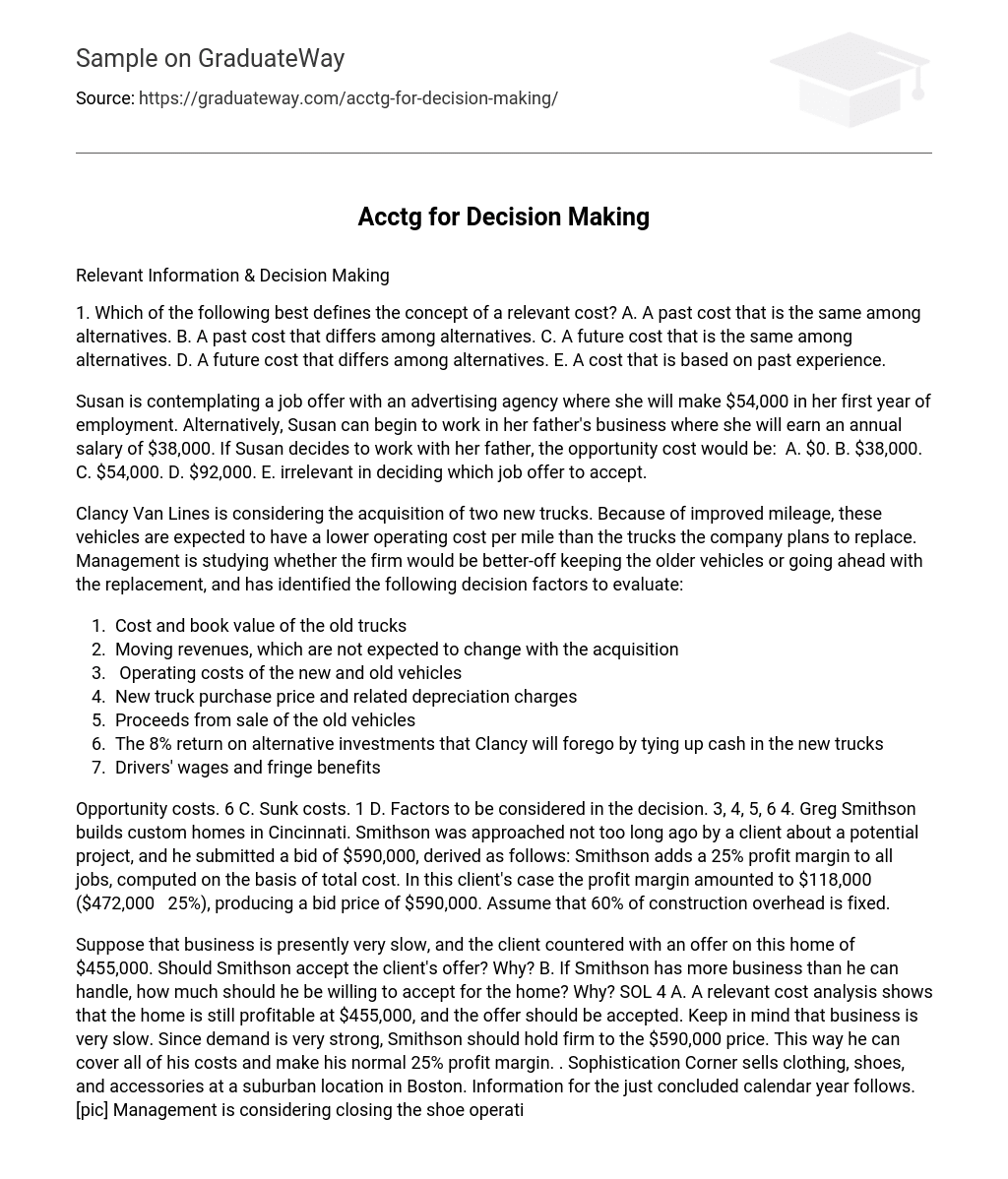Relevant Information & Decision Making
1. Which of the following best defines the concept of a relevant cost? A. A past cost that is the same among alternatives. B. A past cost that differs among alternatives. C. A future cost that is the same among alternatives. D. A future cost that differs among alternatives. E. A cost that is based on past experience.
Susan is contemplating a job offer with an advertising agency where she will make $54,000 in her first year of employment. Alternatively, Susan can begin to work in her father’s business where she will earn an annual salary of $38,000. If Susan decides to work with her father, the opportunity cost would be: A. $0. B. $38,000. C. $54,000. D. $92,000. E. irrelevant in deciding which job offer to accept.
Clancy Van Lines is considering the acquisition of two new trucks. Because of improved mileage, these vehicles are expected to have a lower operating cost per mile than the trucks the company plans to replace. Management is studying whether the firm would be better-off keeping the older vehicles or going ahead with the replacement, and has identified the following decision factors to evaluate:
- Cost and book value of the old trucks
- Moving revenues, which are not expected to change with the acquisition
- Operating costs of the new and old vehicles
- New truck purchase price and related depreciation charges
- Proceeds from sale of the old vehicles
- The 8% return on alternative investments that Clancy will forego by tying up cash in the new trucks
- Drivers’ wages and fringe benefits
Opportunity costs. 6 C. Sunk costs. 1 D. Factors to be considered in the decision. 3, 4, 5, 6 4. Greg Smithson builds custom homes in Cincinnati. Smithson was approached not too long ago by a client about a potential project, and he submitted a bid of $590,000, derived as follows: Smithson adds a 25% profit margin to all jobs, computed on the basis of total cost. In this client’s case the profit margin amounted to $118,000 ($472,000 25%), producing a bid price of $590,000. Assume that 60% of construction overhead is fixed.
Suppose that business is presently very slow, and the client countered with an offer on this home of $455,000. Should Smithson accept the client’s offer? Why? B. If Smithson has more business than he can handle, how much should he be willing to accept for the home? Why? SOL 4 A. A relevant cost analysis shows that the home is still profitable at $455,000, and the offer should be accepted. Keep in mind that business is very slow. Since demand is very strong, Smithson should hold firm to the $590,000 price. This way he can cover all of his costs and make his normal 25% profit margin. . Sophistication Corner sells clothing, shoes, and accessories at a suburban location in Boston. Information for the just concluded calendar year follows. [pic] Management is considering closing the shoe operation because of the loss and expanding the space that is currently devoted to accessories sales. A salaried salesperson in the shoe department who earns $45,000 will be terminated; however, all other departmental fixed costs will continue to be incurred. Sophistication Corner will spend $16,000 on remodeling costs and anticipates that accessories sales will increase by $70,000.
This additional sales revenue is expected to generate a 35% contribution margin for the firm. Finally, because clothing customers often purchased shoes and feel strongly about “one-stop shopping,” clothing sales are expected to fall by 15% if the shoe department is closed. Required: Determine whether the shoe department should be closed. SOL 6 The company is currently earning $55,500 ($50,000 – $20,000 + $25,500). If the shoe department is closed, total income amounts to only $8,000 as shown below, meaning the department should remain in operation. Sales:
The company requires 8,000 units of C15 and 11,000 units of C19. Recently, management decided to devote additional machine time to other product lines, resulting in only 31,000 machine hours per year that can be dedicated to production of the bearings. An outside company has offered to sell Fowler the bearings at prices of $13. 50 for C15 and $13. 50 for C19. Required: A. Assume that Fowler decided to produce all C15s and purchase C19s only as needed. Determine the number of C19s to be purchased. B. Compute the net benefit to the company of manufacturing (rather than purchasing) a unit of C15.
Repeat the calculation for a unit of C19. C. Fowler lacks sufficient machine time to produce all of the C15s and C19s needed. Which component (C15 or C19) should Fowler manufacture first with the limited machine hours available? Why? Be sure to show all supporting computations. SOL 7 C. C15 consumes 2 hours of machine time, thus providing a net benefit of $1. 50 per hour ($3 2). In contrast, C19 consumes 2. 5 hours of time and produces a benefit of $1. 20 per hour ($3 2. 5). On the basis of this information, the company should focus on C15.





